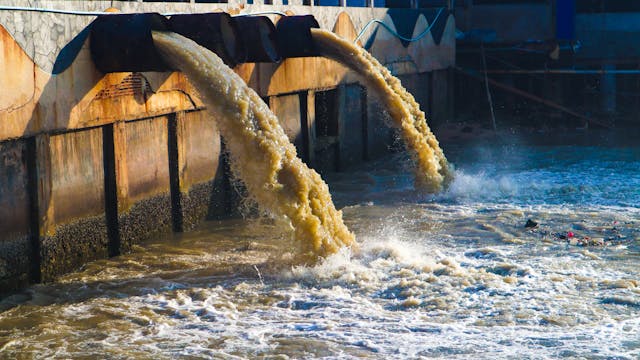Industrial Waste Water Treatment-- Customized Solutions for Effective Wastewater Treatment
Wiki Article
Technologies and Developments in Industrial Waste Water Therapy Technologies
The landscape of commercial wastewater treatment is going through a transformative shift, driven by innovations that boost both performance and sustainability. As regulative requirements progress, the integration of AI and equipment learning into wastewater monitoring systems promises to enhance procedures and make sure conformity.Introduction of Drainage Treatment Technologies
Wastewater therapy modern technologies incorporate a series of techniques created to eliminate pollutants from industrial effluents before their launch right into the atmosphere. These innovations are vital for maintaining ecological equilibrium and ensuring conformity with ecological policies. The primary categories of wastewater therapy consist of physical, chemical, and biological approaches, each offering unique purposes based upon the nature of the pollutants present.

Organic therapy methods utilize microbes to degrade organic issue, making them specifically effective for organic-rich effluents. Techniques like triggered sludge and biofilm activators harness the all-natural degradation abilities of germs, bring about significant reductions in biochemical oxygen demand (BODY)
Advanced Filtering Techniques
Advanced filtration techniques represent an essential evolution in the realm of industrial wastewater treatment, improving the effectiveness of pollutant elimination procedures. Industrial Waste Water Treatment. These approaches incorporate a series of technologies, consisting of microfiltration, ultrafiltration, nanofiltration, and turn around osmosis, which provide sequential obstacles for numerous particle dimensions and chemical frameworksMicrofiltration and ultrafiltration make use of membrane layer systems to get rid of put on hold solids, microorganisms, and bigger natural particles, enhancing the high quality of effluent prior to further treatment. Nanofiltration bridges the gap in between ultrafiltration and turn around osmosis, properly getting rid of organic substances and divalent ions, thus reducing the tons on downstream procedures.
Reverse osmosis uses the highest degree of filtration by enabling only water and small particles to pass via its semi-permeable membranes, making it perfect for reclaiming top quality water from commercial effluents. Recent improvements in membrane technology, consisting of the growth of even more fouling-resistant and resilient materials, have considerably improved operational effectiveness and reduced prices.
Integrating these sophisticated filtration strategies not only boosts the general treatment procedure but additionally adds to sustainability efforts by making it possible for water reuse and resource recuperation in industrial setups. (Industrial Waste Water Treatment)
Biological Therapy Advancements

Additionally, the growth of crafted biological systems, such as membrane bioreactors (MBRs), incorporates biological treatment with innovative membrane filtration. This assimilation permits higher effluent top quality and minimized footprint, making why not find out more it ideal for space-constrained industrial centers. Advancements in genetically engineered microbes have also arised, enhancing the biodegradation of details contaminants, such as drugs and heavy steels, that are typically testing to eliminate.
Additionally, the implementation of bioaugmentation approaches, where useful microbes are presented to enhance the existing organic treatment processes, has actually shown encouraging cause boosting treatment performance. These technologies collectively indicate a trend in the direction of more sustainable and reliable organic treatment methods that can adapt to the progressing intricacies of industrial wastewater streams. As markets proceed to prioritize environmental conformity, these organic developments will certainly play a critical role in wastewater administration.

Source Recovery Methods
In commercial setups, the combination of resource recuperation approaches has become significantly crucial for enhancing sustainability and decreasing waste. These techniques concentrate on drawing out important products and energy from wastewater streams, thereby changing potential toxins into multiple-use sources.One prominent strategy is nutrition recuperation, where nitrogen and phosphorus, commonly present over in wastewater, are captured and exchanged plant foods. This not just reduces ecological influences however likewise provides a circular economy solution for farming applications. Additionally, innovations such as anaerobic digestion enable the conversion of natural waste into biogas, a renewable resource source that can balance out nonrenewable fuel source usage in commercial operations.
In addition, advanced filtration and membrane layer innovations promote the healing of industrial have a peek here by-products such as salts and steels. These recovered materials can be rehabilitated right into manufacturing processes, minimizing the demand for virgin resources.
Future Trends in Waste Water Administration
As sectors increasingly prioritize sustainability, the future of wastewater administration is readied to undertake substantial changes. Technological innovations, such as expert system and artificial intelligence, will certainly make it possible for extra reliable monitoring and management of wastewater systems. These technologies can anticipate maintenance requirements, enhance treatment processes, and improve decision-making, eventually minimizing functional expenses and environmental effect.Additionally, the combination of round economic climate principles will play a vital function in wastewater administration. Industries are expected to change towards systems that not only treat wastewater but additionally recoup beneficial sources, such as nutrients, water, and power. This shift will minimize waste and advertise the reuse of products, lining up with worldwide sustainability goals.
Arising therapy methods, such as membrane bioreactors and progressed oxidation procedures, will even more enhance the performance of wastewater therapy, permitting better effluents appropriate for reuse. Furthermore, regulatory structures are most likely to evolve, emphasizing more stringent requirements for wastewater discharge and motivating markets to adopt cutting-edge therapy services.
Verdict
In final thought, the development of commercial wastewater therapy technologies demonstrates a considerable change Get the facts towards improved effectiveness and sustainability (Industrial Waste Water Treatment). Technologies in advanced filtering strategies, organic treatments, and resource healing techniques highlight the sector's dedication to environmental stewardship.The landscape of industrial wastewater treatment is going through a transformative change, driven by technologies that boost both efficiency and sustainability.Wastewater treatment innovations include a variety of approaches made to get rid of contaminants from industrial effluents before their launch right into the atmosphere.Using the power of organic procedures has actually led to substantial technologies in the therapy of commercial wastewater.In addition, the execution of bioaugmentation approaches, where beneficial microbes are presented to boost the existing organic therapy procedures, has shown promising results in improving therapy performance. These technologies collectively indicate a pattern in the direction of even more lasting and reliable organic therapy approaches that can adjust to the progressing complexities of commercial wastewater streams.
Report this wiki page